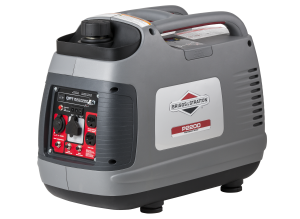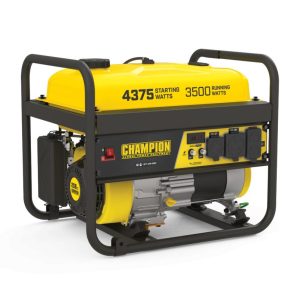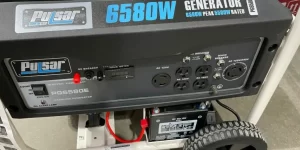Predator Generator Clogs (6 Reasons)
If your engine isn’t producing enough power, is losing speed, or is stalling out, you need to investigate the root of the problem and fix it before it gets worse.
More work than the generator can handle, a filthy carburetor, a clogged fuel filter, a blocked air filter, the improper throttle setting, or a clogged spark arrestor all contribute to a predator generator’s sluggish performance under load.
When working on your generator, be sure you observe all safety procedures. This entails removing the spark plug wire and waiting for the engine to cool down.
Table of Contents
When a Predator Generator Is Overworked, It Fails For These 6 Reasons
1. The Predator Generator is Overworked for Its Capacity
Predator provides a selection of generators with varying load capacities. The maximum watts a generator can take varies across models.
When your generator’s load exceeds its capacity, it will slow down or stop working altogether. The generator and everything connected to it might be in danger as well.
Check the generator’s load limit and the wattage needs of the things you are operating with the generator before inspecting it for anything that might cause it to run rough.
The generator should have both the starting and the operating watts printed on it. The total wattage of everything you have turned on at once must be lower than the generator’s safe operating load.
Temporarily powering appliances that need more energy to get going will push the generator to its beginning load limit.
To figure out the wattage, consider these guidelines.
- Most electrical appliances include a label that specifies their wattage.
- To get going, some engines need a little more juice than others. The required wattage in this scenario should be determined by using the initial wattage.
- To obtain a total, add up the wattage of everything that will be hooked into the generator at once.
- The sum of these watts must be lower than the maximum allowed by the generator.
Keep the generator’s load below its rated capacity. If the machine becomes stuck, turn off the generator immediately. Take everything out of the ports. Start the machine again and add components one by one.
2. Predator Generator with a Filthy Carburetor
The accumulation of varnish in the carburetor might render it ineffective after some time. Old gas will varnish the carburetor’s internals, coating them and blocking fuel passageways.
If there isn’t enough gasoline, there won’t be enough of an explosion when the fuel and air are ignited to start the engine. To fix a clogged carburetor, you’ll have to take it apart and clean or rebuild it.
Take pictures while you disassemble the carburetor to clean it so you can put the minor pieces back where they go when you reassemble it.
Take the generator’s carburetor off. Use a carburetor cleaner to get rid of as much gunk as possible. A carburetor repair kit may be used to replace any worn or broken components. Carburetor installation follows cleaning and fixing.
If you don’t feel comfortable dismantling your carburetor and cleaning and rebuilding it yourself, you may always buy a new one. If your Predator’s carburetor doesn’t start working after being cleaned, you may need to replace it.
3. A Predator Generator With A Clogged Fuel Filter And Sediment Bowl
A Predator generator’s fuel filter prevents debris from entering the fuel system and damaging the engine.
Most generators include a filter screen at the fuel cap to prevent debris from entering the fuel system, but it is also important to have a filter preventing dirt from reaching the carburetor.
You may find one of the following filters in your model:
- Filter for gasoline that is placed inline with the fuel lines.
- At the very bottom of the gas tank is a filter.
- A gasoline component or fuel line gets fitted with a slim filter.
If your vehicle has an inline gasoline filter, you should change it out once a year. Some gasoline shut-off valves have a sediment bowl that must be periodically emptied and cleaned.
Get in touch with a Predator service facility if you have questions about whether or not a fuel filter is utilized and the location of your fuel filter.
4. A Predator Power Plant with a Clogged Air Filter
To prevent even the smallest particles of dirt or debris from entering the engine, an air filter traps them before they can reach the air intake system.
The air filter, like the fuel filter, should be changed at least once a year, and more often if the generator is used frequently or in dusty environments.
How to take care of the air filter in your Predator generator:
- Maintaining a clean and well-checked filter is essential.
- The filter should be changed once a year, or more often if it becomes broken or too unclean.
- The model generator filter should be used.
- Keep the filter on your generator at all times.
Filters may get so clogged with dirt that air can’t get to the engine if they aren’t cleaned and replaced periodically. The engine may stall, overheat, and suffer severe damage as a result.
Before using, make sure the air filter has been cleaned or replaced if necessary. If you want to clean your Predator, just do what it says in the handbook.
Detailed steps for cleaning a few common varieties of air filters are provided below. If you are unclear how to clean your air filter, it is recommended that you refer to the handbook.
Air filter maintenance for a Predator generator using a foam design
- Take out the filter and throw it away.
- Clean the air filter housing and cover with a damp cloth. Keep the air intake free of debris.
- The foam filter should be checked for wear and replaced if necessary.
- Cleaning the filter with soapy water and rinsing it until the water flows clear will determine its condition.
- To dry the filter, just squeeze it.
- Use a clean, light engine oil such as SAE 30 to coat the filter. To get rid of extra oil, squeeze the filter.
- Place the filter in the vent.
- The air filter cover must be reattached.
To clean the paper air filter in a Predator generator:
- Take out the filter and throw it away.
- Clean the air filter housing and cover with a damp cloth. Keep the air intake free of debris.
- Be sure to check the air filter. Lightly tapping the filter might cause the grime to slip out of the filter. Make sure the paper doesn’t get ruined. If the filter is unclean, torn, or no longer effectively seals the air intake, a new one should be installed.
- To remove dust from the filter, Predator suggests using compressed air.
- Put in a new or freshly cleaned air filter.
- The air filter cover must be reattached.
5. A Predator Generator with an Incorrect Choke Setting
Inadequate airflow to the engine may also cause the generator to stall if the choke isn’t adjusted once the engine has warmed up.
One possible cause of this is failing to turn off the engine’s choke once it has warmed up. A jammed choke or malfunctioning switch/dial (depending on model) used to start the generator might also be to blame.
6. A Predator Generator with a Blocked Spark Arrestor
A spark arrestor screen is a component of a Predator generator that is meant to stop sparks and other hot debris from escaping the muffler. The goal here is to lessen the number of people hurt by flames and burns.
If carbon deposits prevent hot exhaust air from passing through this metal screen, the generator will operate roughly or even shut down.
It’s safer to wait until the muffler has cooled before removing the spark arrestor to clean it. Check the condition of the spark arrestor screen by removing it. If the screen has any holes or rips, you should get a new one.
If the screen is still functional, you may clean it with a commercial solvent or brush off the soot with a tiny metal brush. After cleaning, replace the screen on the muffler.








